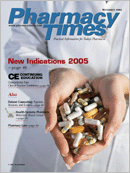Publication
Article
Pharmacy Times
Balacet 325 (propoxyphene napsylate 100 mg and acetaminophen 325 mg)
Balacet 325 (propoxyphene napsylate100 mg and acetaminophen325 mg) has received FDAapproval for mild-to-moderate painmanagement in patients 18 years andolder. Balacet 325 is manufacturedand marketed by Cornerstone Bio-Pharma.1
Pharmacology
Propoxyphene and acetaminophenare familiar drugs to the medical community,and their use—both togetherand alone—has been tested and marketedby various manufacturers foryears. A mild, centrally acting narcoticanalgesic, the structure of propoxypheneis similar to that of methadone.It displays approximately two thirdsthe potency of codeine. Propoxypheneis available in 2 forms: propoxyphenehydrochloride and propoxyphenenapsylate. The bioavailability of 65 mgof propoxyphene hydrochloride isapproximately equivalent to 100 mgof propoxyphene napsylate. A myriadof propoxyphene preparations are currentlyavailable in the United States; itis marketed both alone and in combinationwith acetaminophen.
Unintentional AcetaminophenOverdose
Balacet 325 is promoted to reduceacetaminophen overuse. According tothe United States Pharmacopeia, maximumdaily intake of acetaminophenfor short-term (< 10 days) pain controlshould be <4000 mg; maximum dailyintake for long-term (> 10 days) shouldbe <2600 mg. At its maximum dose,Balacet 325 contributes 1950 mg ofacetaminophen daily. CornerstoneBioPharma, the manufacturer of Balacet325, claims that less than onethird of patients are aware of thepotential for acetaminophen-relatedliver damage. Given acetaminophen'swide availability in both OTC and prescriptionproducts, unintentionaloverdose by patients using acetaminophenfor mild-to-moderate pain controlis a realistic concern. CornerstoneBioPharma hopes to offer a safermeans to decrease pain with Balacet325.1 Balacet 325 can be given as 1tablet up to every 4 hours as needed,with a maximum daily dose of 6tablets.2
Safety
Balacet 325 is contraindicated inpatients with a history of hypersensitivityto propoxyphene or acetaminophen.Its use is also discouraged inpatients with addictive or suicidal tendenciesand in patients currently usingantidepressants, tranquilizers, or excessiveamounts of alcohol. Patients andproviders should be aware that overuseof Balacet 325 may lead to dependenceand/or tolerance. Balacet 325 should beavoided in patients with renal or hepaticimpairment and in women who arepregnant. Geriatric patients may requirea longer dosing interval. The useof Balacet 325 is not approved for use inpediatric patients. Caution should beused in patients concomitantly receivingother medications such as antidepressants,anticonvulsants, or anticoagulants,as propoxyphene is likely toaffect the metabolism of these drugsand alter their levels. Balacet 325 is aSchedule IV medication; appropriatemeasures should be taken in the dispensingof this medication.2
In clinical trials, the most commonadverse reactions to Balacet 325 includeddizziness, sedation, nausea, and vomiting.Other less commonly reportedadverse reactions included constipation,abdominal pain, skin rashes, lightheadedness,headache, weakness, euphoria,dysphoria, hallucinations, and visualdisturbances.2
Dr. Holmberg is a pharmacist with PhoenixChildren's Hospital, Phoenix, Ariz.
For a list of references, send astamped, self-addressed envelope to:References Department, Attn. A. Stahl,Pharmacy Times, 241 Forsgate Drive,Jamesburg, NJ 08831; or send an e-mailrequest to: astahl@ascendmedia.com.







